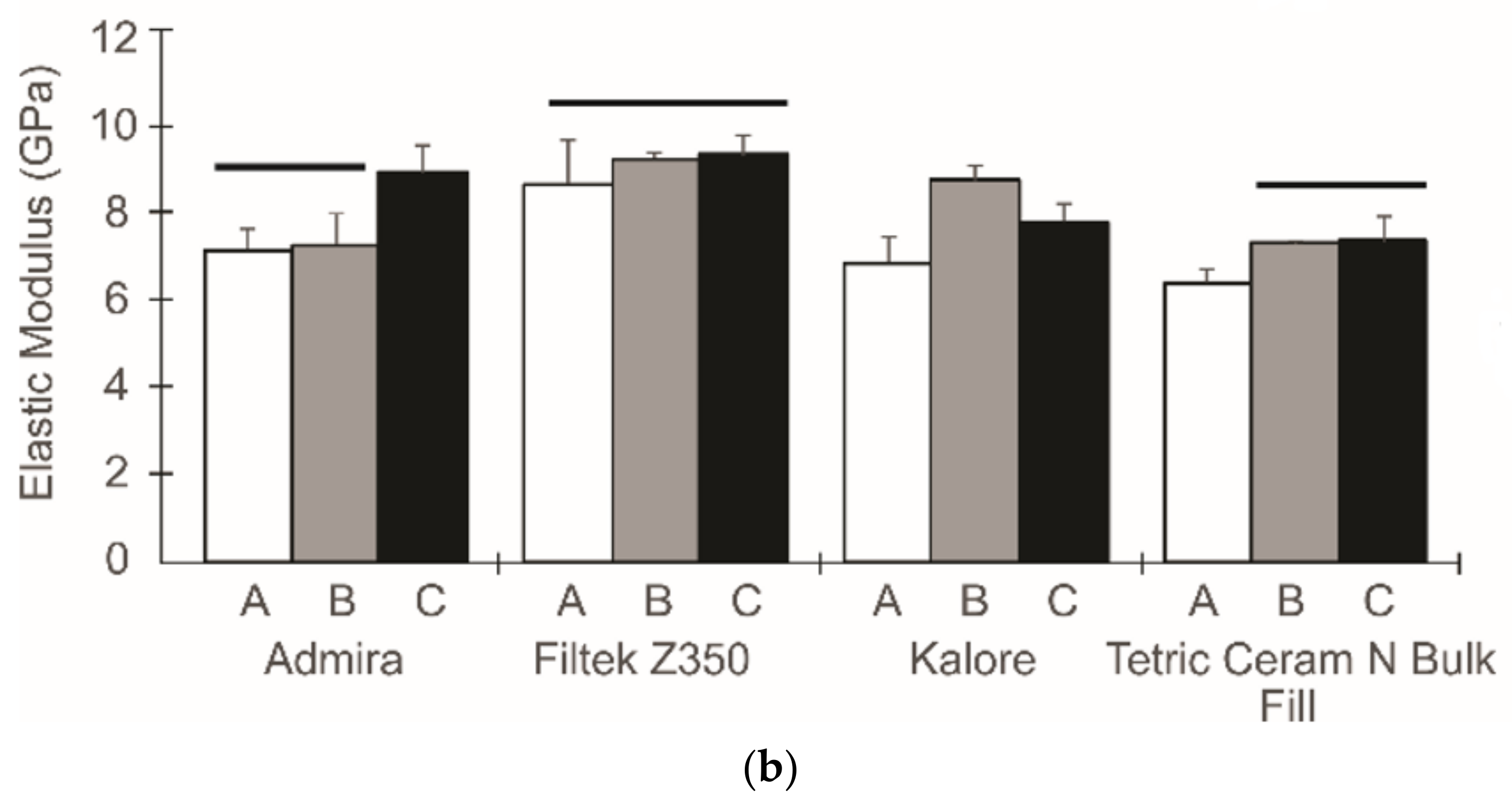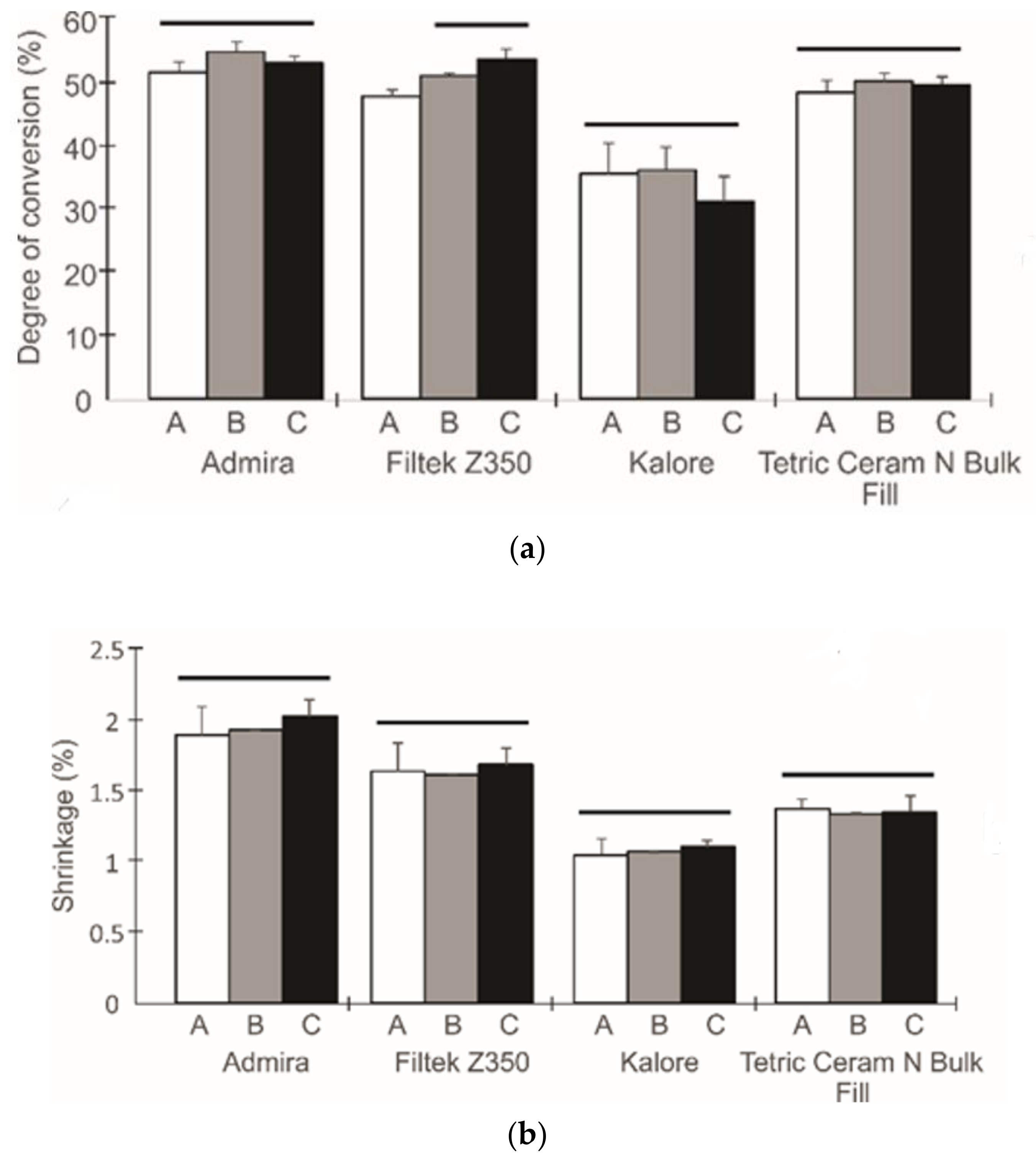Examining the Effect of Radiant Exposure on Commercial Photopolimerizable Dental Resin Composites
Abstract
:1. Introduction
2. Materials and Methods
2.1. Curing Protocols and Radiant Exposures
2.2. Degree of Conversion
2.3. Flexural Properties
2.4. Water Sorption and Solubility
2.5. Polymerization Shrinkage
2.6. Statistical Analysis
3. Results
4. Discussion
5. Conclusions
Author Contributions
Funding
Conflicts of Interest
References
- Society of Cariology and Endodontology, C.S.A. Guidelines for Direct Adhesive Composite Restoration. Chin. J. Dent. Res. 2015, 18, 217–220. [Google Scholar] [CrossRef] [PubMed]
- Devoto, W.; Saracinelli, M.; Manauta, J. Composite in everyday practice: how to choose the right material and simplify application techniques in the anterior teeth. Eur. J. Esthet. Dent. 2010, 5, 102–124. [Google Scholar] [PubMed]
- Rueggeberg, F.A. State-of-the-art: Dental photocuring—A review. Dent. Mater. 2011, 27, 39–52. [Google Scholar] [CrossRef] [PubMed]
- Leprince, J.G.; Palin, W.M.; Hadis, M.A.; Devaux, J.; Leloup, G. Progress in dimethacrylate-based dental composite technology and curing efficiency. Dent. Mater. 2013, 29, 139–156. [Google Scholar] [CrossRef] [PubMed]
- Rueggeberg, F.A.; Caughman, W.F.; Curtis, J.W. Effect of light intensity and exposure duration on cure of resin composite. Oper. Dent. 1994, 19, 26–32. [Google Scholar] [PubMed]
- Zorzin, J.; Maier, E.; Harre, S.; Fey, T.; Belli, R.; Lohbauer, U.; Petschelt, A.; Taschner, M. Bulk-fill resin composites: Polymerization properties and extended light curing. Dent. Mater. 2015, 31, 293–301. [Google Scholar] [CrossRef] [PubMed]
- Peutzfeldt, A.; Asmussen, E. Resin composite properties and energy density of light cure. J. Dent. Res. 2005, 84, 659–662. [Google Scholar] [CrossRef] [PubMed]
- Emami, N.; Söderholm, K.J.M. How light irradiance and curing time affect monomer conversion in light-cured resin composites. Eur. J. Oral Sci. 2003, 111, 536–542. [Google Scholar] [CrossRef] [PubMed]
- Feng, L.; Suh, B.I. Exposure reciprocity law in photopolymerization of multi-functional acrylates and methacrylates. Macromol. Chem. Phys. 2007, 208, 295–306. [Google Scholar] [CrossRef]
- Emami, N.; Söderholm, K.-J.M.; Berglund, L.A. Effect of light power density variations on bulk curing properties of dental composites. J. Dent. 2003, 31, 189–196. [Google Scholar] [CrossRef]
- Vandewalle, K.S.; Ferracane, J.L.; Hilton, T.J.; Erickson, R.L.; Sakaguchi, R.L. Effect of energy density on properties and marginal integrity of posterior resin composite restorations. Dent. Mater. 2004, 20, 96–106. [Google Scholar] [CrossRef]
- Bortolotto, T.; Dagon, C.; Krejci, I. Light polymerization during cavity filling: Effect of “exposure reciprocity law” and the resulted shrinkage forces on restoration margins. Acta Odontol. Scand. 2013, 71, 1296–1302. [Google Scholar] [CrossRef] [PubMed]
- Asmussen, E.; Peutzfeldt, A. Polymerization contraction of resin composite vs. energy and power density of light-cure. Eur. J. Oral Sci. 2005, 113, 417–421. [Google Scholar] [CrossRef] [PubMed]
- Selig, D.; Haenel, T.; Hausnerová, B.; Moeginger, B.; Labrie, D.; Sullivan, B.; Price, R.B.T. Examining exposure reciprocity in a resin based composite using high irradiance levels and real-time degree of conversion values. Dent. Mater. 2015, 31, 583–593. [Google Scholar] [CrossRef] [PubMed]
- Ilie, N.; Hilton, T.J.; Heintze, S.D.; Hickel, R.; Watts, D.C.; Silikas, N.; Stansbury, J.W.; Cadenaro, M.; Ferracane, J.L. Academy of Dental Materials guidance—Resin composites: Part I—Mechanical properties. Dent. Mater. 2017, 33, 880–894. [Google Scholar] [CrossRef] [PubMed]
- International Organization for Standarization. Available online: https://www.iso.org/standard/42898.html (accessed on 6 October 2018).
- Alvarez-Gayosso, C.; Barceló-Santana, F.; Guerrero-Ibarra, J.; Sáez-Espínola, G.; Canseco-Martínez, M.A. Calculation of contraction rates due to shrinkage in light-cured composites. Dent. Mater. 2004, 20, 228–235. [Google Scholar] [CrossRef]
- Ferracane, J.L.; Hilton, T.J.; Stansbury, J.W.; Watts, D.C.; Silikas, N.; Ilie, N.; Heintze, S.; Cadenaro, M.; Hickel, R. Academy of Dental Materials guidance—Resin composites: Part II—Technique sensitivity (handling, polymerization, dimensional changes). Dent. Mater. 2017, 33, 1171–1191. [Google Scholar] [CrossRef] [PubMed]
- Hadis, M.; Leprince, J.G.; Shortall, A.C.; Devaux, J.; Leloup, G.; Palin, W.M. High irradiance curing and anomalies of exposure reciprocity law in resin-based materials. J. Dent. 2011, 39, 549–557. [Google Scholar] [CrossRef] [PubMed]
- Baek, C.-J.; Hyun, S.-H.; Lee, S.-K.; Seol, H.-J.; Kim, H.-I.; Kwon, Y.H. The effects of light intensity and light-curing time on the degree of polymerization of dental composite resins. Dent. Mater. J. 2008, 27, 523–533. [Google Scholar] [CrossRef] [PubMed]
- Wydra, J.W.; Cramer, N.B.; Stansbury, J.W.; Bowman, C.N. The reciprocity law concerning light dose relationships applied to BisGMA/TEGDMA photopolymers: Theoretical analysis and experimental characterization. Dent. Mater. 2014, 30, 605–612. [Google Scholar] [CrossRef] [PubMed] [Green Version]
- Palin, W.M.; Fleming, G.J.P.; Burke, F.J.T.; Marquis, P.M.; Randall, R.C. Monomer conversion versus flexure strength of a novel dental composite. J. Dent. 2003, 31, 341–351. [Google Scholar] [CrossRef]
- Münchow, E.A.; Meereis, C.T.W.; de Oliveira da Rosa, W.L.; da Silva, A.F.; Piva, E. Polymerization shrinkage stress of resin-based dental materials: A systematic review and meta-analyses of technique protocol and photo-activation strategies. J. Mech. Behav. Biomed. Mater. 2018, 82, 77–86. [Google Scholar] [CrossRef] [PubMed]
- Ferracane, J.L. Hygroscopic and hydrolytic effects in dental polymer networks. Dent. Mater. 2006, 22, 211–222. [Google Scholar] [CrossRef] [PubMed]
- Cramer, N.B.; Stansbury, J.W.; Bowman, C.N. Recent Advances and Developments in Composite Dental Restorative Materials. J. Dent. Res. 2011, 90, 402–416. [Google Scholar] [CrossRef] [PubMed]
- Sakaguchi, R.L.; Ferracane, J.L. Effect of light power density on development of elastic modulus of a model light-activated composite during polymerization. J. Esthet. Restor. Dent. 2001, 13, 121–130. [Google Scholar] [CrossRef] [PubMed]
- Reis, A.F.; Vestphal, M.; do Amaral, R.C.; Rodrigues, J.A.; Roulet, J.-F.; Roscoe, M.G. Efficiency of polymerization of bulk-fill composite resins: A systematic review. Braz. Oral Res. 2017, 31, e59. [Google Scholar] [CrossRef] [PubMed]
- Jung, J.H.; Park, S.H. Comparison of Polymerization Shrinkage, Physical Properties, and Marginal Adaptation of Flowable and Restorative Bulk Fill Resin-Based Composites. Oper. Dent. 2017, 42, 375–386. [Google Scholar] [CrossRef] [PubMed]
- Goracci, C.; Cadenaro, M.; Fontanive, L.; Giangrosso, G.; Juloski, J.; Vichi, A.; Ferrari, M. Polymerization efficiency and flexural strength of low-stress restorative composites. Dent. Mater. 2014, 30, 688–694. [Google Scholar] [CrossRef] [PubMed]
- Thomaidis, S.; Kakaboura, A.; Mueller, W.D.; Zinelis, S. Mechanical properties of contemporary composite resins and their interrelations. Dent. Mater. 2013, 29, e132–e141. [Google Scholar] [CrossRef] [PubMed]
- Wang, L.; D’Alpino, P.H.P.; Lopes, L.G.; Pereira, J.C. Mechanical properties of dental restorative materials: relative contribution of laboratory tests. J. Appl. Oral Sci. 2003, 11, 162–167. [Google Scholar] [CrossRef] [PubMed] [Green Version]
- Randolph, L.D.; Palin, W.M.; Leloup, G.; Leprince, J.G. Filler characteristics of modern dental resin composites and their influence on physico-mechanical properties. Dent. Mater. 2016, 32, 1586–1599. [Google Scholar] [CrossRef] [PubMed]
- Azad, E.; Atai, M.; Zandi, M.; Shokrollahi, P.; Solhi, L. Structure–properties relationships in dental adhesives: Effect of initiator, matrix monomer structure, and nano-filler incorporation. Dent. Mater. 2018, 34, 1263–1270. [Google Scholar] [CrossRef] [PubMed]
- Malacarne, J.; Carvalho, R.M.; de Goes, M.F.; Svizero, N.; Pashley, D.H.; Tay, F.R.; Yiu, C.K.; de Oliveira Carrilho, M.R. Water sorption/solubility of dental adhesive resins. Dent. Mater. 2006, 22, 973–980. [Google Scholar] [CrossRef] [PubMed]
- Gonçalves, F.; Boaro, L.C.C.; Miyazaki, C.L.; Kawano, Y.; Braga, R.R. Influence of polymeric matrix on the physical and chemical properties of experimental composites. Braz. Oral Res. 2015, 29, 1–7. [Google Scholar] [CrossRef] [PubMed] [Green Version]
- Han, S.H.; Sadr, A.; Tagami, J.; Park, S.H. Internal adaptation of resin composites at two configurations: Influence of polymerization shrinkage and stress. Dent. Mater. 2016, 32, 1085–1094. [Google Scholar] [CrossRef] [PubMed]
- Jang, J.-H.; Park, S.-H.; Hwang, I.-N. Polymerization Shrinkage and Depth of Cure of Bulk-Fill Resin Composites and Highly Filled Flowable Resin. Oper. Dent. 2015, 40, 172–180. [Google Scholar] [CrossRef] [PubMed]
- Soares, C.J.; Faria-e-Silva, A.L.; de Paula Rodrigues, M.; Vilela, A.B.F.; Pfeifer, C.S.; Tantbirojn, D.; Versluis, A. Polymerization shrinkage stress of composite resins and resin cements—What do we need to know? Braz. Oral Res. 2017, 31. [Google Scholar] [CrossRef] [PubMed]
- Narene, A.V.K.; Veniashok, B.; Subbiya, A.; Vivekanandhan, P.; Sukumaran, V.G. Polymerisation shrinkage in resin composites—A review. Middle East J. Sci. Res. 2014, 21, 107–112. [Google Scholar] [CrossRef]
- Ausiello, P.; Cassese, A.; Miele, C.; Beguinot, F.; Garcia-Godoy, F.; Di Jeso, B.; Ulianich, L. Cytotoxicity of dental resin composites: An in vitro evaluation. J. Appl. Toxicol. 2013, 33, 451–457. [Google Scholar] [CrossRef] [PubMed]




| Material | Organic Matrix * | Inorganic Filler * | Filler Load %Weight (Volume) |
|---|---|---|---|
| KaloreTM (GC Corp., Tokyo, Japan) | UDMA, Urethane DX-511, dimethacrylate comonomers | Fluoro-aluminium-silicate glass, Prepolymerized filler, and Silicon dioxide | 82 (55) |
| Admira® (Voco, Cuxhaven, Germany) | Polisiloxane, aliphatic and aromatic monomers | Apatite-sulphate-phosphate and inorganic glass particles | 78 (56) |
| Tetric® N-Ceram Bulk Fill (Ivoclar-Vivadent, Schaan, Liechtenstein) | Bis-GMA, DMA | Barium-aluminium-silicate glass, ytterbium fluoride, and spherical mixed oxide | 79 (60) |
| FiltekTM Z350 XT (3M ESPE, St. Paul, MN, USA) | Bis-GMA, UDMA, TEGDMA, Bis-EMA, PEGDMA. | Silica, zirconia, and aggregated zirconia/silica clusters | 72.5 (63.3) |
| Material | Flexural Strength (MPa) | Elastic Modulus (GPa) | Water Sorption (µ/mm3) | Solubility (µ/mm3) | Degree of Conversion (%) | Shrinkage (%) |
|---|---|---|---|---|---|---|
| FiltekTM Z350XT | 80.52 (15.88)a | 9.13 (0.66)a | 15.93 (1.70)a | 1.00 (0.60)ab | 50.96 (2.77)ab | 1.66 (0.15)b |
| KaloreTM | 59.63 (10.13)b | 7.85 (0.89)b | 12.30 (1.01)bc | 0.74 (0.36)b | 33.72 (4.18)c | 1.07 (0.08)d |
| Tetric® N-Ceram Bulk Fill | 60.37 (11.05)b | 7.05 (0.60)b | 11.85 (1.08)c | 0.96 (0.26)ab | 49.50 (1.53)b | 1.36 (0.08)c |
| Admira® | 54.17 (14.20)b | 7.76 (1.11)b | 13.49 (1.22)b | 1.39 (0.47)a | 53.36 (1.79)a | 1.96 (0.15)a |
© 2018 by the authors. Licensee MDPI, Basel, Switzerland. This article is an open access article distributed under the terms and conditions of the Creative Commons Attribution (CC BY) license (http://creativecommons.org/licenses/by/4.0/).
Share and Cite
Cuevas-Suárez, C.E.; Pimentel-García, B.; Rivera-Gonzaga, A.; Álvarez-Gayosso, C.; Ancona-Meza, A.L.; Grazioli, G.; Zamarripa-Calderón, E. Examining the Effect of Radiant Exposure on Commercial Photopolimerizable Dental Resin Composites. Dent. J. 2018, 6, 55. https://doi.org/10.3390/dj6040055
Cuevas-Suárez CE, Pimentel-García B, Rivera-Gonzaga A, Álvarez-Gayosso C, Ancona-Meza AL, Grazioli G, Zamarripa-Calderón E. Examining the Effect of Radiant Exposure on Commercial Photopolimerizable Dental Resin Composites. Dentistry Journal. 2018; 6(4):55. https://doi.org/10.3390/dj6040055
Chicago/Turabian StyleCuevas-Suárez, Carlos Enrique, Belinda Pimentel-García, Alejandro Rivera-Gonzaga, Carlos Álvarez-Gayosso, Adriana Leticia Ancona-Meza, Guillermo Grazioli, and Eliezer Zamarripa-Calderón. 2018. "Examining the Effect of Radiant Exposure on Commercial Photopolimerizable Dental Resin Composites" Dentistry Journal 6, no. 4: 55. https://doi.org/10.3390/dj6040055
APA StyleCuevas-Suárez, C. E., Pimentel-García, B., Rivera-Gonzaga, A., Álvarez-Gayosso, C., Ancona-Meza, A. L., Grazioli, G., & Zamarripa-Calderón, E. (2018). Examining the Effect of Radiant Exposure on Commercial Photopolimerizable Dental Resin Composites. Dentistry Journal, 6(4), 55. https://doi.org/10.3390/dj6040055






